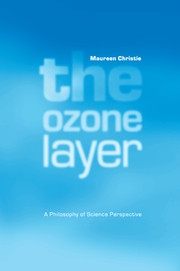Book contents
- Frontmatter
- Contents
- List of figures
- List of abbreviations
- Preface
- 1 Introduction
- Part I History of the understanding of stratospheric ozone
- Part II Philosophical issues arising from the history
- 9 Prediction in science
- 10 The crucial experiment
- 11 Positive and negative evidence in theory selection
- 12 Branches and sub-branches of science: problems at disciplinary boundaries
- 13 Scientific evidence and powerful computers: new problems for philosophers of science?
- 14 The scientific consensus
- References
- Index
11 - Positive and negative evidence in theory selection
Published online by Cambridge University Press: 22 September 2009
- Frontmatter
- Contents
- List of figures
- List of abbreviations
- Preface
- 1 Introduction
- Part I History of the understanding of stratospheric ozone
- Part II Philosophical issues arising from the history
- 9 Prediction in science
- 10 The crucial experiment
- 11 Positive and negative evidence in theory selection
- 12 Branches and sub-branches of science: problems at disciplinary boundaries
- 13 Scientific evidence and powerful computers: new problems for philosophers of science?
- 14 The scientific consensus
- References
- Index
Summary
Many scientific textbooks include a small section headed ‘The Scientific Method’, or something similar. It contains a brief description of the way that the authors believe scientists investigate, evaluate evidence, and incorporate new knowledge into the body of science. It is usually very idealised, and often prescriptive and over-simplified. Consider the following two extracts from such sources:
An important point to remember about theories is that they can seldom be proven to be correct. Usually, the best we can do is fail to find an experiment that disproves a theory.
(Brady, 1990, p. 5)Theories are, however, only tentative. A theory continues to be useful only as long as we fail to find any experimental facts that cannot be accounted for by the theory. But only one fact that the theory cannot explain will cause the theory to be modified or replaced by a new theory.
(Gillespie et al., 1986, p. 91)The essential feature of Popper's philosophy of science that has been so influential among scientists and philosophers alike is his breaking of the symmetry between confirmation of a theory, and falsification of a theory. The idea is that it is possible to use experimentation to disprove a theory, but not to establish it. The notion that falsification is possible, while confirmation is not, is an over-simplification.
- Type
- Chapter
- Information
- The Ozone LayerA Philosophy of Science Perspective, pp. 122 - 148Publisher: Cambridge University PressPrint publication year: 2001



